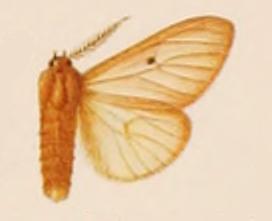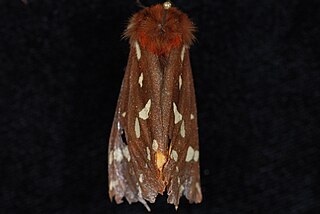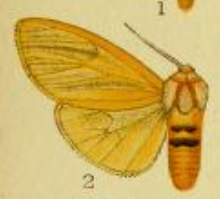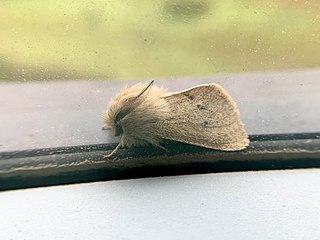
The buff ermine is a moth of the family Erebidae. It is sometimes placed in the genus Spilosoma. The species was first described by Johann Siegfried Hufnagel in 1766. It is found throughout the temperate belt of the Palearctic region south to northern Turkey, Georgia, Kazakhstan, southern Siberia, eastern Mongolia, Amur Region, China, Korea and Japan.

Spilosoma virginica is a species of moth in the subfamily Arctiinae. As a caterpillar, it is known as the yellow woolly bear or yellow bear caterpillar. As an adult, it is known as the Virginian tiger moth.

Spilosoma lubricipeda, the white ermine, is a moth of the family Erebidae. It is found throughout the temperate belt of Eurasia from Europe through Kazakhstan and southern Siberia to Amur Region, China, Korea and Japan. In China several sibling species occur.

Spilosoma urticae, the water ermine, is a moth of the family Erebidae. It is found in temperate belt of the Palearctic realm like similar Spilosoma lubricipedum, but prefers drier biotopes. So, S. urticae is more abundant in steppes and it is the single Spilosoma species in Central Asia.

Spilosoma is a genus of moths in the family Erebidae originally described by John Curtis in 1825. A very heterogeneous group, it is in need of review by the scientific community, as certain species probably need reclassification into their own genera.

Spilosoma pellucida is a moth of the family Erebidae. It was described by Walter Rothschild in 1910. It is found in Ghana.

Properigea albimacula is a small to medium-sized moth in the family Noctuidae first described by William Barnes and James Halliday McDunnough in 1912. It is found in the western US on the slopes of Cascades north of Oregon and almost throughout California. The wingspan is about 15 mm. Adults fly during the summer and are most common during July. This species is nocturnal and comes to lights.

Arctia parthenos, the St. Lawrence tiger moth, is a moth in the family Erebidae. It was described by Thaddeus William Harris in 1850. It is found in boreal North America, ranging from Alaska to Labrador, south to New Mexico and Arizona in the Rocky Mountains and to North Carolina in the Appalachian Mountains. The habitat consists of riparian areas and mixed hardwood-conifer forests at middle to high elevations.
Spilosoma extrema is a moth in the family Erebidae. It was described by Franz Daniel in 1943. It is found in Yunnan, China.
Spilosoma yemenensis is a moth in the family Erebidae. It was described by George Hampson in 1916. It is found in Yemen.
Spilosoma danbyi, or Danby's tiger moth, is a moth in the family Erebidae. It was described by Berthold Neumoegen and Harrison Gray Dyar Jr. in 1893. It is found in North America, where it has been recorded from Washington and western Canada from British Columbia to Manitoba.
Spilosoma bipartita is a moth in the family Erebidae. It was described by Walter Rothschild in 1933. It is found in Angola, Congo, Kenya, Malawi, South Africa, Tanzania and Zimbabwe.
Spilosoma castelli is a moth in the family Erebidae. It was described by Walter Rothschild in 1933. It is found in Senegal and Nigeria.

Spilosoma occidens is a moth in the family Erebidae. It was described by Walter Rothschild in 1910. It is found in the Democratic Republic of the Congo, Ghana, Nigeria, Senegal and Sierra Leone.

Spilosoma togoensis is a moth in the family Erebidae. It was described by Max Bartel in 1903. It is found in Cameroon, the Central African Republic, the Democratic Republic of the Congo, Equatorial Guinea, Ghana, Ivory Coast, Nigeria and Togo.
Spilosoma dubia, the dubious tiger moth, is a moth in the family Erebidae. It was described by Francis Walker in 1855. It is found from south-eastern Canada west to Alberta and in the eastern United States. The habitat consists of aspen parkland and southern boreal forests.
Spilosoma latipennis, the pink-legged tiger moth, or the red-legged diacrisia, is a moth in the family Erebidae. It was described by Richard Harper Stretch in 1872. It is found in eastern North America, where it has been recorded from Georgia, Indiana, Iowa, Kansas, Kentucky, Maine, Maryland, New Brunswick, New York, North Carolina, Ohio, Ontario, Pennsylvania, South Carolina, West Virginia and Wisconsin.

Spilosoma vestalis, the Vestal tiger-moth, is a moth in the family Erebidae. It was described by Alpheus Spring Packard in 1864. It is found along the coast of western North America, from California north to the Kitsap Peninsula in Washington and western Idaho.

Spilosoma vagans, the wandering diacrisia or wandering tiger moth, is a moth in the family Erebidae. It was described by Jean Baptiste Boisduval in 1852. It is found in western North America, from southern California, southern Utah and central Colorado north to southern British Columbia and south-western Alberta. The habitat consists of drier forests, including open ponderosa pine forests and mixed hardwood-conifer forests.

Euxoa tristicula, the early cutworm, is a moth of the family Noctuidae. It was first described by Herbert Knowles Morrison in 1876 and is found in the United States and Canada, where it ranges from southern British Columbia, south through Oregon to central California along the coast. The habitat consists of coastal rainforests, mixed hardwood forests, and mixed hardwood-conifer forests at low to middle elevations west of the Cascades.












